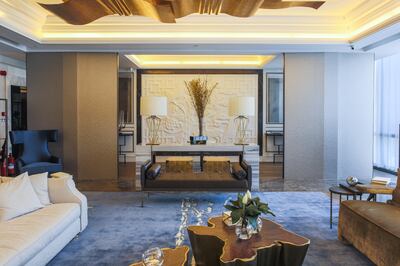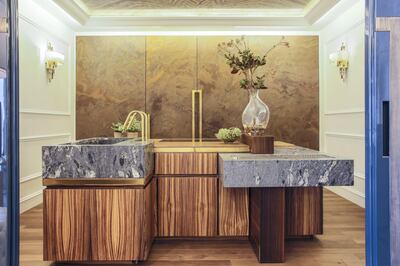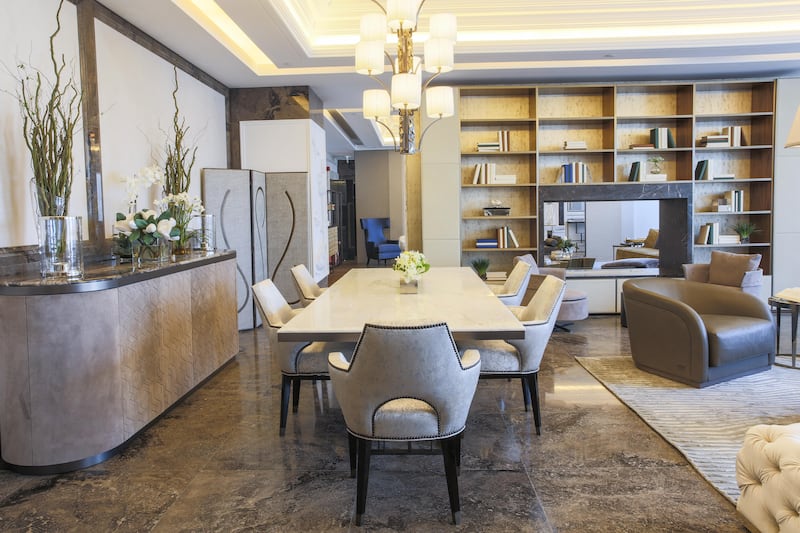Hidden high up in one of the many skyscrapers flanking Dubai's Emaar Square is a space specifically designed to give shape and form to the idea of luxury living. Part show apartment, part creative playground, the one-bedroom flat was painstakingly put together by Issarch, a Dubai-based design studio specialising in interiors, architecture and furniture.
"It's a place where clients can touch, see, understand and be inspired," says Ilaria Paci, Issarch's business development manager.
With cushions covered in Hermès fabrics, wallpapers crafted from banana leaves and a freestanding, bronze-coated bathtub standing in the corner of the bedroom, this apartment is a manifestation of what your home might look like if money were no object – and you had some of the world's best designers and furniture manufacturers on speed dial. "This is what we think a house should look like," Issarch architect Antonio Minutella says. "It's a selection of nice things. Or what we think are nice things. I think it's completely unique in the UAE."
The design is defined by its deft command of colour, and by how it employs unexpected shapes and finishes. A neutral palette is given depth through texture, and interspersed with pops of brightness, from a rich midnight blue carpet in the living room to a lime green accent chair sitting in a corner.

Wall and ceiling treatments are a testament to the level of detail incorporated into the interior. Often overlooked, here ceilings are covered in metallic waves or recessed moulding. Walls are smothered in stunning marble effects and silk wallpapers made from threads of gold and silver. This is taken to its decorative extreme in the entrance area, where a large statement wall is completely covered in a faux-stone relief.
If the design does slip into excess, it quickly draws itself back, calling on the simplest of decorative elements, such as a succulent sitting on a pile of books, or a single flower extending from a clear glass vase.
Access to the show apartment is by invitation-only, a conscious decision intended to wrap the entire endeavour in a shroud of exclusivity.
"Issarch is a very different concept for Dubai because it is an atelier, but it is private. Our show apartment is only for VIPS and only by appointment," Paci says.
And yet as over the top as this may sound, the space is actually an artful exercise in restraint. Everything is crafted from the finest materials and is clearly eye-wateringly expensive, but there is none of the ostentation that has long been the cornerstone of "luxury" in this part of the world.
This, says Mimi Manuel, Issarch's senior interior decorator, is the point. Armed with this show space, the team hopes to encourage UAE residents to take a new, more contemporary approach to the design of their homes.
"It is very forward-looking," Manuel says. "Instead of focusing on what was traditional and what might capture the older generation, we tried to look at the younger generation, which is a lot more global. They've studied abroad and travel on a monthly basis. That's the lifestyle we are trying to tap into."
"Another important thing is that we don't only do projects in this region; we work around the world," Minutella is quick to add. "We have projects in London, Paris, the south of France, Italy, the UAE, all over the place. So this house could be anywhere in the world."
The kitchen is an interesting case in point. A central island is formed from a gorgeous grained wood, topped with chunky slabs of grey slate. Overhead, a white-marble ceiling adds an extra touch of luxuriousness to what is traditionally a highly utilitarian space. The overall effect is raw, natural and exceptionally beautiful.

Running along one side of the kitchen are heavy double doors clad in rare stone. "This was from a very limited quarry," Manuel explains. "We went in the cave and asked for that specific piece. It was quite difficult to get it here."
The doors fold back for the big reveal: a sizeable pantry where all your white goods, appliances, and unsightly pots, pans and perishables can be hidden away. "We tried to create a room that people can move around in, and also want to stay in – not just cook for five minutes and then leave," Manuel says.
"It is not in the culture to see the kitchen as part of the house, as a convivial place where you gather," Paci says. "We are trying to shift perceptions while respecting the culture."
Some of the furniture brands that Issarch represents that are featured here are Longhi, Boca do Lobo, Koket and Brabbu. Throughout the apartment, there is a focus on Italian-made, customised, one-off creations – the Hermès cushions being an obvious example. Elsewhere, an enormous shelving unit is used to separate the living room from a slightly less formal family room, but has been specially reconfigured so that an indoor fireplace sits at its centre. Coffee tables are made from chunks of tree trunk, mixed with brass.
"Luxury is when you have something unique that no one else has. A piece that is yours, that you cannot find anywhere else," Paci says. "We work with a lot of brands and everything you see here has been customised for us, either in terms of colour or size or shape."
Best of all, this project offered an element of freedom that interior designers and architects are rarely granted over the course of their careers. There was no brief, no demanding client and, as such, no major creative compromises to be made. "We could play," Minutella concludes with a smile.






